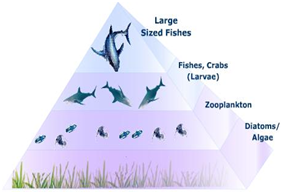Biotic component are parts of an ecosystem. They consist of all organisms such as plants, animals and various microorganisms. Based on their function in the ecosystem, biotic components are grouped into producers, consumers and decomposer
Producers
Producers are organisms that produce food for both themselves and other organisms. All plants and photosynthetic organisms are producers because they can photosynthesize. During the photosynthesis, water and CO2 are converted into carbohydrate and O2. Due to their ability to manufacture their own food, plants are called autotroph organism.
Consumers 
Consumers are organisms that eat other organisms because they cannot manufacture their own food. Consumers are categorized into primary consumer, secondary consumer and tertiary consumer. The primary consumers directly eat the producers, for example goats, zooplankton and rabbits.
The organisms that indirectly depend on producers are called second and tertiary consumers.Examples of secondary consumers are frog, small fish ,bird , cats, while snakes, eagles, shark and tiger are example of tertiary consumer
Decomposer 
Decomposer is organisms that decompose organic materials of dead organisms into inorganic ones. The inorganic materials resulted from this process fertilize the land since they are rich of nutrients necessary for the soil. The decomposers include bacteria and fungi. Can you imagine how the earth will be without decomposer? If there were no decomposers, the earth would be full of stocks of garbage and remnants of organisms.
Source from book:
Hewitt, paul et al. 2007. Conceptual Integrated science. United state Of America: Pearson Education, Inc
Source from internet:
Erle Ellis. 2011. Ecosystem on http://www.eoearth.org
Franklin Institute. 2009. Ecosystems, Biomes, and Habitats on http://www.fi.edu
Paul Billiet and Shirley Burchill. 2011. Living and Non-living Things on http://www.saburchill.com
Source of picture:
Energy Pyramid on http://schoolworkhelper.net
Decomposer on http://www.geography4kids.com